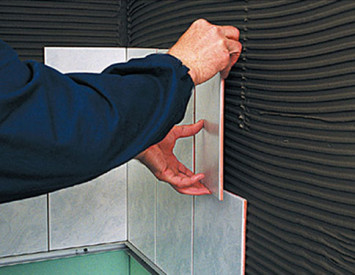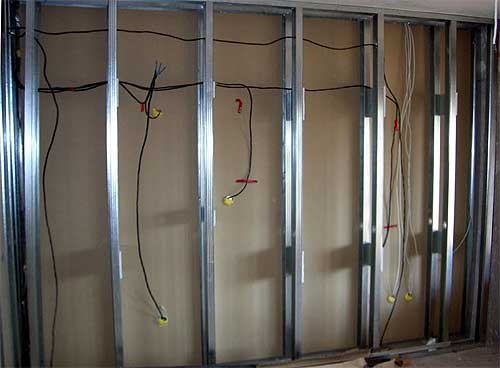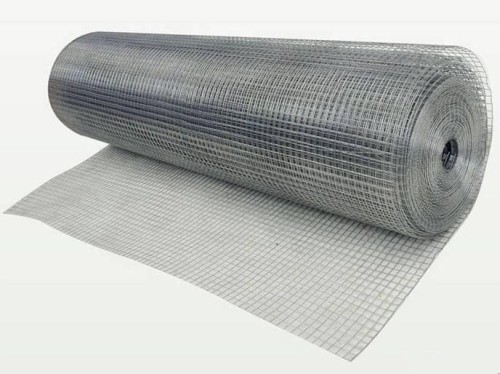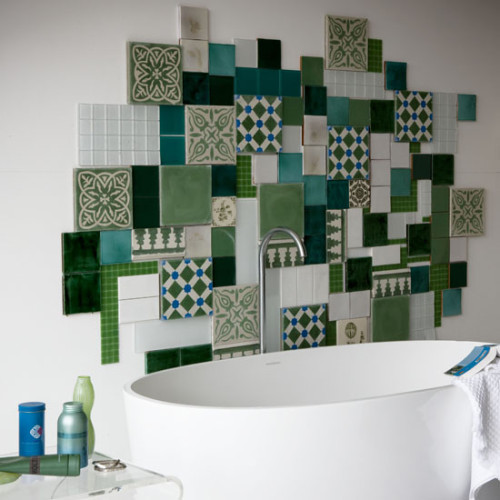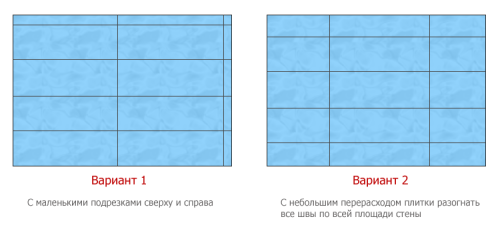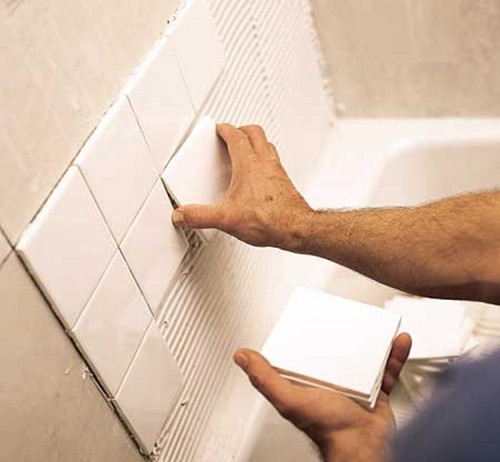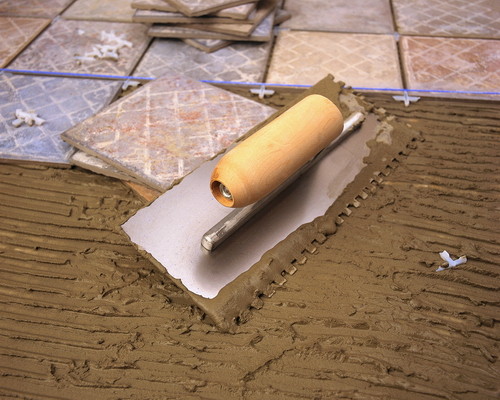Gypsum cardboard can be called universal building material, which is literally suitable for everything - wall decoration, creating decorative partitions, building furniture, protective structures and much more. But, the main thing, for what appreciate Gypsum cardboard is the ability to quickly and inexpensively create a perfectly smooth surface suitable for facing with any materials. Especially good on drywall walls lies Tiles, but working with these two materials has its own specifics. In this article, we will tell you how to put tiles on drywall.
Content
Characteristics of the material
Gypsum cardboard has long been one of the most popular building materials used for decoration of premises. It can be laid on the floor, attached to the walls, and what are the ceilings even and smooth from it! The material itself is a gypsum powder compressed in the plate, pasted on two sides by a construction cardboard. IN him There are no additives, chemicals and other extraneous impurities - only natural components. That is why drywall can be used everywhere - in residential buildings, children's institutions, in industries and in public buildings.
Environmental friendliness is not the only advantage of drywall. But we will not list them all, but touch Only what is necessary directly for laying tiles is a flat surface. As you know, you can only put tiles on a perfectly even base. Traditionally, lime, gypsum and cement plasters were used for this, but in some cases, changes and surface defects are so significant that it is easier and cheaper to cover her Hypsum plasterboard slabs than to coat with a thick layer of plaster mixture.
For reliable fixation of plasterboard plates preliminarily installed an elementary crate from wooden rails or metal profile. It remains just screw the screws and smear the cracks putty. You can start laying tiles on drywall almost immediately after its installation.
Choice of drywall for tiles
Plasterboard slabs are produced by semi -dry pressing. The most ordinary slab consists of gypsum and fluffed Pulp waste paper on both sides. The thickness of the material can be different, as well as the characteristics of the external cardboard shell. Conventional products are afraid of water, so laying tiles on drywall in the bathroom is not possible. For this, there is a special type of material, resistant to humidity and temperature differences.
There are two main varieties of drywall:
- GVL - Unlike conventional drywall, where cellulose layers are located outside, paper fibers are evenly distributed along the gypsum “filling” and compressed in a single plate. Thus, this material acquires greater strength and high fire and technical characteristics. After the pressing, the sheets are treated with a special mixture from shallow, that is, the material does not crumble and does not get dirty, however When cutting it, a lot of dust is formed. GVL is used for wall cladding, dry floor screed, to create good sound insulation.
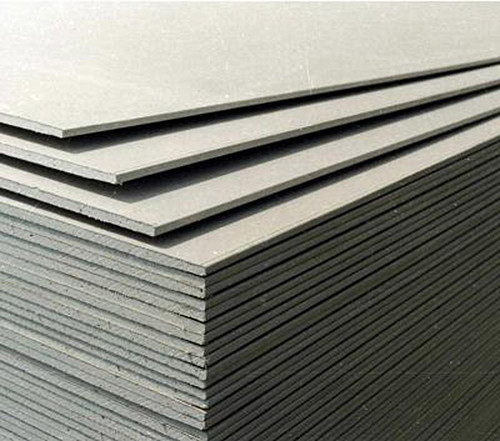
- GVVV – gypsuminoconfect Sheets processed hydrophobizer. They should be used to lay tiles on drywall into a bath or kitchen. But despite own low water absorption, material is necessary for good support in the form of a system ventilation in room (exhaust ventilation in bathroom) and cladding with moisture -resistant material.
Since tiles are usually laid in rooms with a high level of humidity, we will be interested in, first of all, gypsum -haired Moisture -resistant material. If you want to put tiles on drywall on floor, for example, in the hallway, for such a relatively dry room you can use strong GVL.
Glue for tiles
The choice of glue is as important as the choice of drywall, especially when speech goes About repair in the bathroom or in the kitchen. Before buying, read the instructions for use and the list of surfaces on which glue can be used. It is best to take special compositions for drywall.
Today it is not so difficult to find the desired glue - a wide range is replete with suitable options, and some manufacturers even have special glue for tiles for drywall.
What compositions are suitable for work:
- Cement -based mixtures for applying to a paper surface.
- Elastic tile glue for applying to the tile ( sold V the form of powder, which It is necessary to dilute with water to a pasty consistency).
- "Liquid nails" — Universal binder based on water dispersion. Firmly sticks anything to what I wish how And deserved great popularity. On sale there are special atmospheric and moisture resistant options.
Useful advice: if you bought a glue that should be kneaded yourself, do not prepare a big one at once volume - You may not have time to spend it before solidification. The best option is to knead so much glue that is enough for 1 m² of area or slightly less.
Masonry technology
Tiles in itself are enough heavy, even if speech goes About a thin decorative coating. For this reason not each sheet of drywall can withstand her weight. Thin slabs can bend and deform over time, and so that this does not happen, it is necessary to strengthen them properly. To do this, use special guide rails. They are mounted on equal distance along the entire area of \u200b\u200bthe wall. The optimal step of installing guides is 40 cm, but if the sheets are too thin, then it can be reduced to 25 —30 cm.
Guides can be made of wood or metal profiles. They are installed vertically, and then a drywall is attached with self -tapping screws or long brackets. To enhance the strength of the wall and in avoiding joint deformation after laying tiles of drywall can be mounted in two layers. This is exactly what builders do in Western countries, while chatter It is located only under the lower layer - between the wall and the slabs.
An alternative to the guide can serve as a reinforcing plaster mesh. It not only increases the strength of the base for laying tiles, but also does not allow the cardboard shell of drywall to swell from moisture from the glue. The best and reliable the solution will be set the slabs on crate And strengthen them with a plaster net - so you will be sure that the tile will not fall off the wall under any conditions. For gluing the grid, the usual construction is used PVA and brackets.
Tile mounting scheme
Before putting tiles on a drywall with your own hands, it is recommended to develop and draw a tile laying scheme, that is, create a detailed pattern on a suitable scale indicating the exact location of each element. This will not only avoid errors when laying and seeing an approximate final result, but also purchase an exact number of building materials. Buying tiles is still better with a small margin in case of repair, or if you have it will not work smoothly Cock any element.
By the way About sawing. Rarely when it is possible clearly “Enter” tiles into space without dubs or gaps. More often will lack a small piece or ¾ tiles. It is better for such a case to stock up on such a case plitcore. Since you are unlikely to regularly put tiles on drywall, it is wiser to purchase elementary manual titting cutter Or take the mechanism for rent. Even the most cheap titting cutter will allow you to divide the wall tiles, but for thick floor products you will need a device more serious. In addition, it will be unsuitable get a set lightre dli am a perforator with which you can make round holes in a tile, for example, for wires, fasteners or sockets.
To quickly calculate how much tiles you need on the wall, measure her (walls) height and length, find the area and compare the result with the dimensions of the selected tile. At calculations Consider the distance interpretation seams - it can be from 1 to 3 mm.
If it turns out that the last element in the row enters 3/4, means You need to start placing tiles on drywall from the front part, placing a cut tile in the corner so that this is not so striking. If the full row is not enough less than half of the width of the tile, then the installation should start with the center of the wall so that evenly cut elements are obtained in the corners. So You you will get it symmetry and accuracy of the appearance of the wall.
Gluing tiles on drywall
So after all calculations And purchases of the necessary materials can finally begin to facing the wall.
Ka kpinch tiles on drywall:
- Nobody sticks tiles on dry drywall - first it needs to be prepared. To do this, cover all the joint seams between the sheets with a moisture -resistant puttyTo make the wall perfectly even. Wait for complete drying putty. The composition should be designed specifically for working with drywall, so check this moment with the seller.
- Cover the wall with a primer designed to increase adhesion with tile glue. It will be necessary to apply two layers - smear the second time only after the first layer dries (for this will leave 1.5-2 h). To work, you will need a painted roller and a short pile or a wide painting brush.
- When the primer dried up, prepare the glue (if you need to cook). More Once we remind you that you should not knead a lot of glue at once, and after you spill a portion, rinse thoroughly capacity. If you prepare a new glue in tare With the remnants of the previous one, its capturing ability will drop sharply.
- Since the tiles on the wall are never laid on the floor with the floor, it is necessary to attach the support rail to distanceequal height Tiles. That is, the bar should seem to support the second row from the floor. Before fixing it her Self -tapping screws, make markings with a simple pencil, checking horizontality by the construction level.
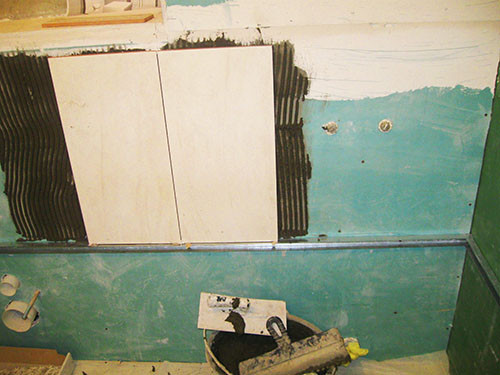
- Start laying tiles according to the selected scheme - or from center, or from The edges of the wall. Cover the first tile on the rail and continue to put the following elements vertically or horizontally. Make sure that the space between the tiles is filled with adhesive solution, and do not forget to insert spacer plastic crosses.
Smell the back of the tile or wall completely, without gaps and not sparing the solution. If voids are formed, then the strength of the clutch will be low, and over time the tiles in these places may fall off.
Insert the crosses in joints between four tiles. They come in different thicknesses - depending on which gap you want to leave. It is not worth saving on crossings, since the accuracy of the masonry depends on them to a greater extent. - When you fit 4 —5 horizontal rows, take a break for hour and half. During this time, the voltage in the base will become less, the glue will grasp a little, and the masonry will not collapse under its own weight.
Constantly check the evenness of the masonry by the construction level.
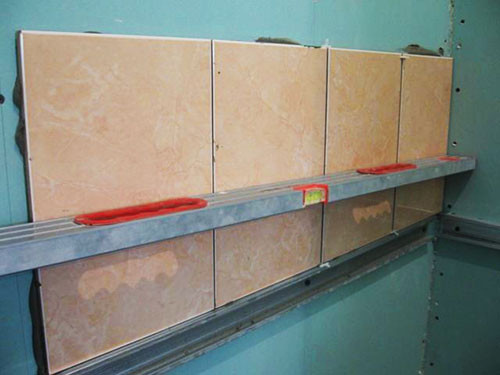
- After that, you can continue to work and close the rest of the wall. In the process, glue will appear between the tiles, and it is better to immediately wipe it with a damp rag, because after solidification it will be much more difficult to do. When all the tiles are on the wall, leave her For a day until the full hardening of the glue.
- After 24 hours, you can proceed to the final stage - grout of the seams.
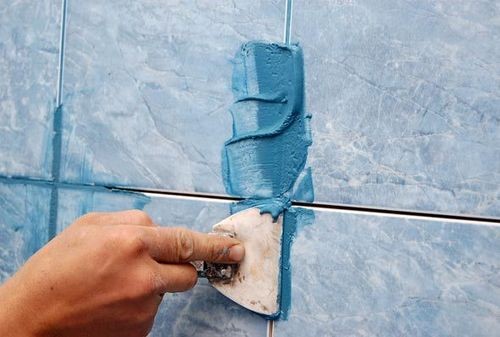
The grouting composition is best selected Based on Tile colors. In most cases, a white or light gray grout is used, as this is the most neutral option. But if you want to behawed, you can choose a contrasting color, for example, black Tiles with white seams, red tiles - with black, green - With yellow grout. It is enough to buy a special pigment, and you can paint the seams in any color.
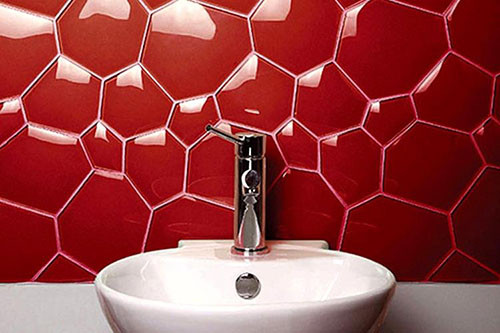
Grind the joints between the tiles with a rubber elastic spatula. - After drying the grout (after a day), smear the seams with a protective waterproof varnish with a thin brush.
All features of laying tiles on drywall in video format:
Recommendations of specialists
Finally, we suggest you familiarize yourself with useful tips from professional builders. These recommendations will help you figure it out the first time, ka klying tiles on drywall.
Useful tips:
- It is better to choose a deep penetration for drywall, so that it completely impregnes the plate and protects her from the effects of moisture and temperature changes.
- Always apply two layers of primer, waiting between them for at least an hour.
- You can apply a primer with a roller or flat brush, but for the subsequent laying of tiles it is best to work tot grater. Even edge graters Place the soil on the wall, and distribute to the gear her poethe tops so that even grooves remain.
- In order for the glue to grasp as firmly as possible, its consistency should resemble a thick sour cream, but not be loose.
- Press the tile to the wall with your hands, and if you work with large tiles, use rubber clay or wooden hammer.
Now you know how to stick tiles on drywall, and we hope that this article will help you make a quality and beautiful repair without involving specialists.
